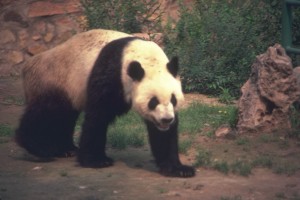

|
|
Giant panda
The giant panda (Ailuropoda melanoleuca), a member of the family Ursidae, differs from other bears in that it has a white and black pelt and subsists mainly on bamboo. A stocky animal with a lumbering gait, a giant panda can grow to a length of 1.5 m and a weight of 75 to 160 kg. It has a sixth thumblike digit on its front paws that it uses to grasp bamboo stems and bring them to its mouth. Its Chinese name daxiongmao, meaning giant bear-cat, comes from its pupils with their vertical slits, like those of felines. Single and solitaryDuring the breeding period, from mid-March to mid-May, the male and female spend one or two days together. In September, the female gives birth to one, two or three tiny, helpless infants, weighing just 90 to 130 g each, or barely 1/900th of the mother's weight. Usually, only one of the newborns survives. Young pandas are nursed by their mother until the age of six months, when they start eating bamboo. They may be attacked by leopards or wild dogs when young, but after 30 months, when they have reached about 80 kg, they no longer have any natural predators. Adult giant pandas are mostly solitary creatures. In the wild, giant pandas have a life expectancy of only 5 or 6 years. In captivity or under more favourable conditions, however, it is thought that they could live 20 or 30 years. Red pandaThe lesser panda (Ailurus fulgens) belongs to the same family as racoons. It is commonly associated with the giant panda, because it also eats bamboo, using the thumblike finger on its front paws to help gather the stems. The lesser panda is about the size of a large cat and has thick reddish brown fur. It is about 60 cm in length and weighs not more than 5 kg. Its bushy, ringed tail may be 50 cm long. It lives in mountain forests in Asia. A protected species
The giant panda lives in six mountainous regions in the People's Republic of China, mostly in Sichuan Province. The total population of this fully protected species is estimated at only about one thousand. China has set aside twelve nature reserves to help ensure the giant panda's survival. Since 1961, it has been used as the logo for the World Wildlife Fund (WWF). The giant panda lives in forests at altitudes of 2,500 to 3,200 m. It must have ready access to stands of bamboo, its main food source. Depending on the season, it eats bamboo stems, branches or leaves, a good source of protein. It devours large quantities to meet its energy requirements: 45% of its body weight every day, or the equivalent of 38 kg of bamboo shoots. A carnivoreSome surprising morphological adaptations show the close link between the panda and bamboo. Its teeth are made for grinding, it has a broad head and powerful jaws for chewing and, especially, it has a sixth thumblike digit on its front paws that it uses for grasping and stripping the outer sheath from bamboo. While its diet is essentially herbivorous, the giant panda is considered a carnivore because its digestive tract is not really adapted to a strictly vegetarian diet. In fact, it does not process bamboo very well, digesting only about 17% of its nutrients, whereas a true herbivore would digest 80%. It occasionally eats other plants, and sometimes fish or small rodents. | The Architecture | The Elements | The Activities | The Society of the Chinese Garden | |


